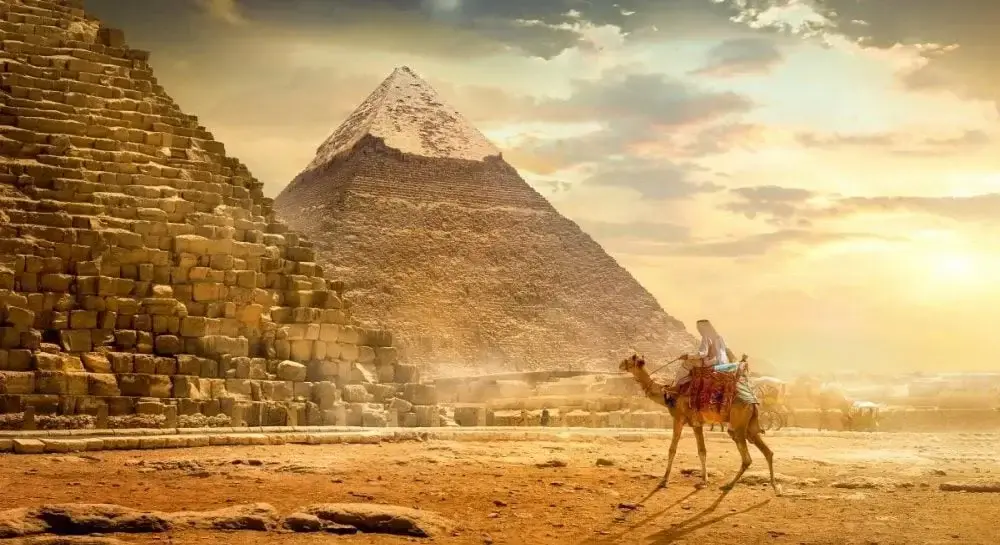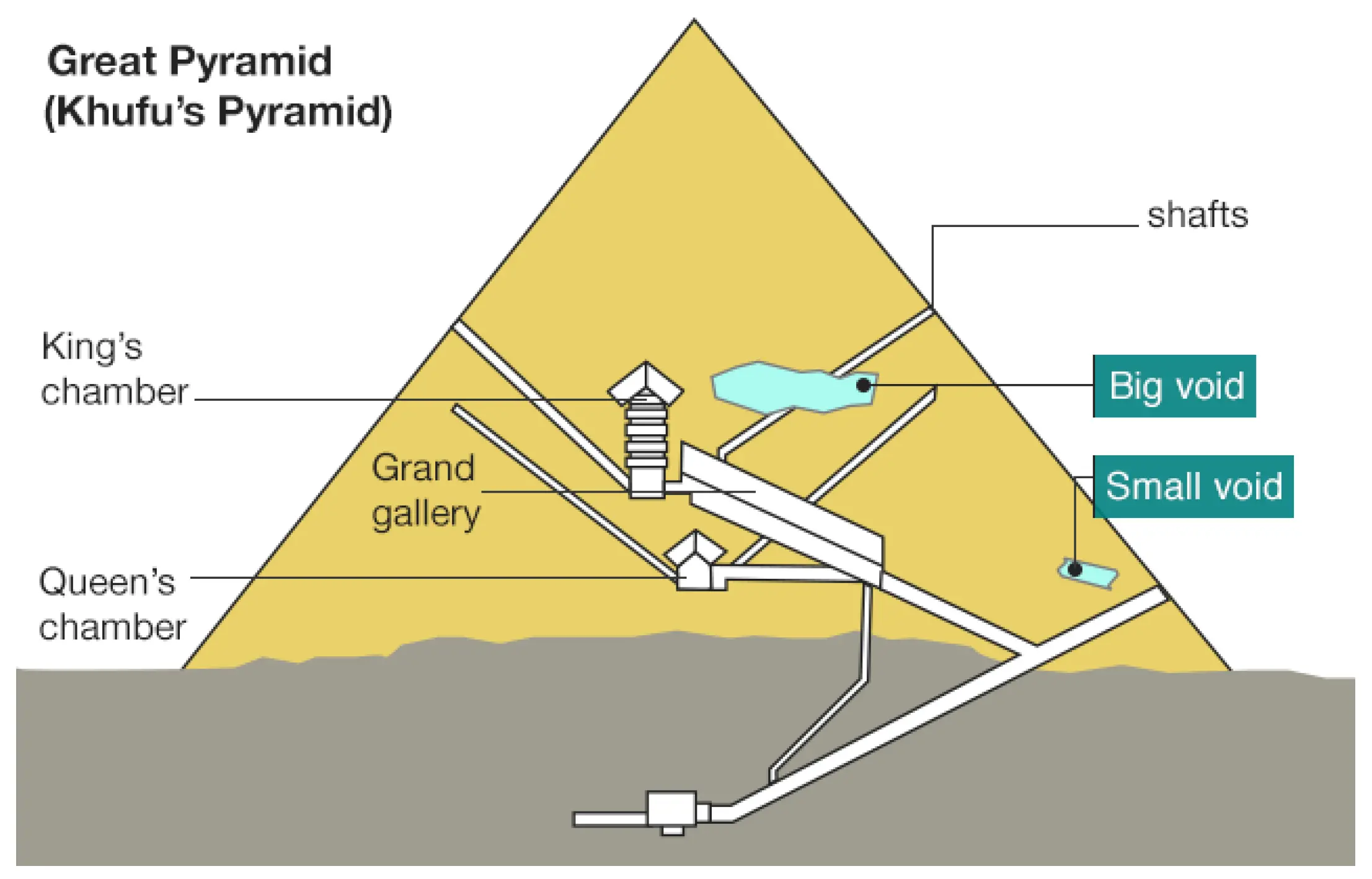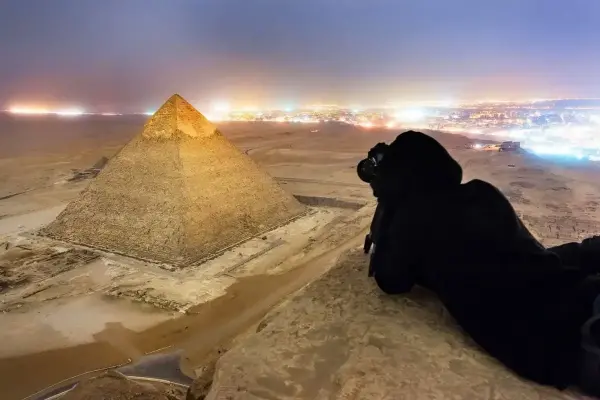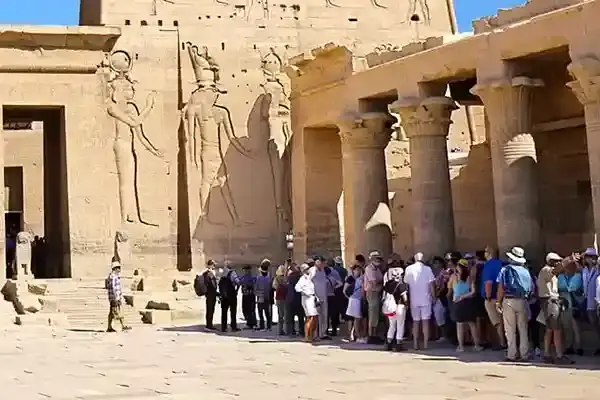How interesting it is to learn about the history of building the Egyptian pyramids, the extent of the development of the Egyptian pharaohs in many different arts, including drawing, sculpture, photography, and decoration, and how they preceded the world thousands of years ago in architectural and construction development that still enjoys great fame in the world.
. In this article, we’ll answer which period—the Ancient Egypt, Middle Kingdom, or New Kingdom—saw the greatest popularity of pyramid construction. Additionally, we’ll examine the differences between ancient Egyptian art and the art of Tell el-Amarna, and explore the famed temples of Deir el-Bahari.
Table of contents [Show]
- Were the pyramids the most common royal tombs during the New Kingdom
- Pyramids were most popular during which of the following periods
- During which period were pyramids the most popular?
- What is Egyptian art with the exception of the Amarna period?
- How is Amarna art different from traditional Egyptian art?
- Which of the following describes the function of the pyramids?
- A magnificent mortuary temple was built at Deir el Bahri for which of the following pharaohs?
- Conclusion
Were the pyramids the most common royal tombs during the New Kingdom
The pyramids were most popular in which of the following periods by burial: the New Kingdom, the Middle Kingdom, the Old Kingdom
In the Old and Middle Kingdoms (2686-1650
the pyramids were the main burial place, especially for kings and queens, to protect the mummified bodies and buried treasures from damage or theft, because the pharaohs buried their possessions and valuables with them, believed that there was an afterlife in which they could use their belongings
The pharaohs chose the tombs based on the person's status before death
The poor were buried in graves of sand covered with straw and they were also buried in tombs close to the rich so that they could benefit from some valuable tools after death
In the new kingdom
in the new kingdom, the pyramids were no longer the main burial place, and the shape of modern tombs differed from the pyramids from the inside
The tomb of the new kingdom was hidden in Thebes, which is the religious center of the modern kingdom because it has many temples and tombs
The pharaohs in the new kingdom chose different types of tombs, such as the flat-topped hill-like terraces and the tombs carved from the rocks in the Valley of the Kings
If you want to see the pyramids and enjoy learning about their amazing wonders and secrets, the Egypt online tour can help you take a trip to Egypt to visit the Egyptian pyramids

The pyramids were most popular during which of the following periods: the pre-dynastic period, the early dynastic period, the Middle Kingdom, or the New Kingdom?
Egypt witnessed prosperity and progress in building pyramids during the dynastic era from the beginning of the Third Dynasty to the Sixth Dynasty, and the popularity of the pyramids increased over the centuries until now. Egypt achieved economic development and cultural prosperity from the Third Dynasty to the Fourth Dynasty. Kings had a great position in society because the Egyptians considered them. Let's explain how the construction of the pyramids has evolved: At the beginning of the dynastic era, the construction of pyramids began and was called mastabas. The first pyramid was built for King Zoser (King of the Third Dynasty) in 2630 BC in Saqqara and was called the step pyramid.
After that, the Red Pyramid was built in Dahshur in the Fourth Dynasty by King Sneferu (2589-2613).
The construction development of the pharaohs continued until the Great Pyramid of Giza was built by King Khufu, which became one of the Seven Wonders of the World (2589-2566) Three small pyramids were discovered next to it for the queens of Khufu, and a tomb containing an empty coffin for Khufu's mother was also found.
After Khufu, Khafre built the middle pyramid to have a tomb after his death (2558-2532). Menkaure built the smaller pyramid after Khafre (2532-2503). The era of building pyramids ended at the hands of King Pepi (the second king of the 6th dynasty). The Old Kingdom began to collapse, and the kings did not have a great societal position. The beginning of Middle Kingdom began, which did not witness fame in building pyramids like the Old Kingdom.
Read Also: Strange Facts About The Pyramids
The ancient pyramids of Giza were built during the most advanced and prosperous periods of Egypt's civilization and economy. We mentioned earlier that the period of fame of building the pyramids from the ancient kingdom until the end of the Ptolemaic era, and the pyramids are still popular in all countries of the world, and tourists flock to them to enjoy their picturesque view and learn a lot about the civilization of the ancient Egyptians in construction and architecture.
The fame of the pyramids increased with time and they still enjoy their fame now, and thus tourists flock to them from all countries of the world to enjoy their amazing views and discover the extent of the progress of the Egyptian pharaohs, and the antiquity of the ancient Egyptian civilization.Do not hesitate because we spare no effort to make you feel comfortable and enjoy your trip.
Read about: Can You Go Inside The Great Pyramids
What is Egyptian art with the exception of the Amarna period?

The ancient Egyptian civilization, from about 3000 BC to 30 AD, was distinguished by many arts, including drawing, photography, decoration, and sculpture.
The art of drawing
The ancient Egyptians were attached to natural landscapes and they played an important role in the development of the art of drawing. They used to draw on all the vessels that were buried by the kings to help them be happy in the afterlife. They also used to draw on the walls of the mastabas that were used for burial before the construction of the pyramids. They used to draw a complete unit for the Egyptian life that the Egyptians lived, such as plants, trees, and animals. They used to choose colors from nature. They used to draw on the walls of the tombs from the outside and inside, describing the story of the historical battles in which the person was victorious.
The art of photography
enabled the ancient Egyptians to convey to us a vivid image of all aspects of ancient life as if they were photographed by a camera, such as a drawing of geese and their movements as they lean right and left searching for food. There are examples in which the ancient Egyptian artist expresses different subjects from daily life, such as scenes of fields, doum trees, fieldwork, and the floor of Akhenaten’s palace, which is distinguished by the presence of drawings of groups of ducks flying over papyrus bushes, and groups of fish in their different shapes as if they were swimming in the water.
sculpture
Egyptian sculpture is part of ancient Egyptian art and there are many statues in the temples that express the extent of the progress of the pharaohs in sculpture, through which they express their ideas and beliefs such as immortality. There are many carved statues such as the statue of Khafre in the Egyptian Museum made of green diorite stone. It is a unique statue that has preserved its wonderful artistic value.
The statue of the country is made of sycamore wood that evokes the meaning of eternity through his penetrating gaze. The artist was able to transform a piece of wood into a human image with complete meaning.
The statue of Nefert and Ra in the Egyptian Museum is made of colored limestone. Here the Egyptian artist showed aspects of delicacy and beauty.
Art of decoration
The art of decoration distinguished the ancient Egyptians. The drawings were inspired by nature, such as the lotus flower, papyrus, plant leaves, grape clusters, and the sun disk. The Egyptian artist used natural colors in decoration, such as red, yellow, green, blue, black, and brown. They made decorations with elegance, delicacy, and unparalleled beauty. There are many examples of decoration, such as decoration on furniture, utensils, clothes, musical instruments, chairs, and their backs in the shape of animal heads, and jewelry such as necklaces, earrings, rings, and bracelets.
Read: Is The Sphinx Older Than The Pyramids
How is Amarna art different from traditional Egyptian art?
The style of sculpture changed completely during the Tell el-Amarna period from the late 18th Dynasty when King Akhenaten moved the capital to Tell el-Amarna. Art gained a sense of movement and activity in the images, as bas-relief was used. The sculpture of the figures became more realistic by sculpting statues with other specifications, such as the length of the neck, arms, hands, and fingers, the slope of the forehead and nose, and the appearance of the ears and lips in a large way. All the statues of King Akhenaten appeared with wide thighs and thin arms and legs, which is the opposite of ancient Egyptian art, which showed the bodies completely sculpted, but in Tell el-Amarna, the sculpture of the figures was incomplete out of respect for the god Aten.
Which of the following describes the function of the pyramids?

We learned in the previous paragraphs The pyramids were most popular in which of the following periods: They are the pre-dynastic period, the early dynastic period, and the Old Kingdom.
We will learn about the different functions of the pyramids, which are:
Tombs
The pyramids were built to be tombs for the pharaohs and important figures in society, to preserve all the valuable possessions buried with the kings.
Religious rituals
The pyramids had religious significance related to religious worship and rituals.
symbol of courage and power
The pyramids reflect the extent of the development of the pharaohs and their strength in the art of construction and architecture
astronomical alignment
The pyramids are linked to celestial bodies; therefore, they were used to determine astronomical phenomena and dates
cultural symbol
The pyramids express the extent of the development of the culture and civilization of the pharaohs.
Architectural development.
The construction of the pyramids witnessed a great development in architecture, construction, and building, making the pyramids one of the best manifestations of the development of the art of architecture in the world.
Read about: Did Thoth Built The Pyramids
A magnificent mortuary temple was built at Deir el Bahri for which of the following pharaohs?
A magnificent funerary temple was built at Deir el-Bahari housing the following pharaohs:
Hatshepsut Temple
Hatshepsut Temple is one of the most famous temples in Deir el-Bahari.
Its walls display Queen Hatshepsut's journey to Punt, Somalia, and Hatshepsut's Divine Birth.
The temple is a group of columns arranged in a sloping manner. Although many images of Queen Hatshepsut have been lost, this place is a place of great beauty in Egypt.
The Temple of Mentuhotep II
The Temple of Mentuhotep II is one of the oldest temples in Deir el-Bahari. King Mentuhotep II ruled Egypt from 2040 to 1991 BC. He was one of the pharaohs of the Eleventh Dynasty and he was the one who unified the country in the Middle Kingdom. The king performed religious ceremonies for the gods in this temple.
Funerary Temple of Thutmose III
The funerary temple of Thutmose III, which was dedicated to the worship of the god Amun, was built next to the temple of Hatshepsut, who was his co-king.
Discover Egypt Like Never Before with Our Tailored Tours!

1. Ultimate Egyptian Adventure: Cairo, Aswan, Luxor & Hurghada
Embark on the 10 Days Cairo, Aswan, Luxor & Hurghada Overland Tour and discover Egypt’s incredible diversity—from the ancient pyramids of Cairo to the relaxing Red Sea beaches in Hurghada.
2. Historic Sites in Just 8 Days: Pyramids & Nile by Air
Save time and maximize your exploration with our 8 Days Pyramids & The Nile by Air tour. See Egypt's iconic sites with ease, flying between Cairo and the Nile’s ancient wonders.
3. Classic Egypt Experience: Cairo, Luxor, and Aswan
Immerse yourself in Egypt’s historic cities on the 8 Days Cairo, Luxor, Aswan Classic Tours, a journey through its most storied sites and timeless attractions.
4. Desert Wonders and Ancient Treasures: Cairo to Abu Simbel
Venture on the 8 Days Cairo to Abu Simbel and Back Overland, exploring Egypt’s remote and majestic landscapes along with Abu Simbel’s iconic temples.
5. Quick Journey Through Egypt: Cairo and Luxor in 5 Days
The 5 Days Cairo to Luxor Tour Packages is designed for travelers short on time but keen on exploring Egypt’s most famous monuments and temples.
6. Diverse Egypt: Pyramids, Nile, and Sinai in 12 Days
Our 12 Days Pyramids, Nile & Sinai Tour combines Egypt’s most revered historical sites with the mystic beauty of the Sinai Peninsula for a truly immersive journey.
7. Luxurious Nile Cruise & Historic Sites in 10 Days
Relax and explore with our 10 Days Round Trip Nile Cruise and Pyramids tour, blending the timeless sights of Cairo with a luxurious cruise along the Nile.
8. Classic Egypt and Coastal Relaxation: Cairo & Sharm El Sheikh
The 7-Day Explore Classical Egypt, Cairo & Sharm El Sheikh Tour gives you the best of both worlds with historical exploration and a serene coastal retreat.
9. Cairo and Alexandria Adventure in 5 Days, 4 Nights
Travel through history with the 5 Days, 4 Nights Cairo and Alexandria Adventure, from Cairo’s Great Pyramids to Alexandria’s Mediterranean charm.
10. Full Egyptian Experience: Cairo, Nile Cruise & Red Sea
Our 11 Days of Classic Egypt, Cairo, Nile Cruise & Red Sea combines ancient wonders with Red Sea relaxation, ideal for a comprehensive experience.
11. The Complete Egyptian Journey in 15 Days
Discover all of Egypt's historical landmarks with the 15-Day Classic Tours of the Wonders of Ancient Egypt, an in-depth tour covering iconic sights from Giza to Abu Simbel.
12. Explore Cairo and Relax with a Nile Cruise Adventure
The 7 Day Egypt Adventure Discover Cairo's Splendor & Relax on a Nile Cruise provides a blend of city exploration and tranquil Nile cruising.
Conclusion
Pyramids were most popular in which of the following periods: the pre-dynastic period, the early dynastic period, the ancient kingdom and it is still world-renowned. It reflects the development of the Pharaohs in architecture and construction.
The pyramids were built between the third and sixth dynasties for many reasons, such as burying the pharaohs and preserving the precious tools buried with them. Also, building the pyramids had religious and astronomical rituals, as it was a symbol of power.
The Egyptian pharaohs were skilled in fine arts, such as drawing and decoration using colors, and the art of sculpture, which left many statues carved with special specifications that reflect the extent of civilizational development.
Popular Categories
Related tours
Cairo, Aswan, and Luxor
-
Starting From
$ 2,850
-
Type
Package
Cairo, Aswan, and Luxor
-
Starting From
$ 1,600
-
Type
Package
Cairo, Aswan, and Luxor
-
Starting From
$ 1,850
-
Type
Package











